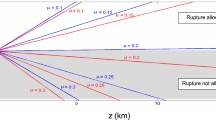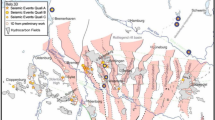Abstract
From August 1976 to June 1979, more than 220 seismic events were recorded by a 7-station network operating over an active gas field in France. 120 earthquakes with magnitudes greater than 1.0 were selected for a detailed study in order to understand the seismic response to a decrease in the gas reservoir pressure of 50 MPa. Composite focal mechanisms were determined for these events. We found that where preexisting fractures were known from well-logs, faults with the most favorable orientation were reactivated. In the part of the gas field where no preexisting faults were known, orientation of the fracture planes was close to the orientations of stratigraphic interfaces.
Our kinematic model, constrained by the distribution of the earthquakes and their focal mechanisms, consists of the downward dropping of a block located close to the top of the gas field. The main faults, as defined by the spatial density of the seismic activity, define the limits of this block. The displacements observed along these faults can be either normal or reverse mechanism, dependent on the preexisting orientation of each fault. Another important result is the evidence that the depletion of the gas reservoir exerts the major influence on local seismic displacements, obscuring the effect of regional setting.
Similar content being viewed by others
References
Cash, D., Homuth, E. F., Keppler, H., Pearson, C., andSasaki, S. (1983),Fault Plane Solutions for Microearthquakes Induced at the Fenton Hill Dry Rock Geothermal Site: Implications for the State of Stress Near a Quaternary Volcanic Center, Geophys. Res. Lett.10, 1141–1144.
Coustau, R. (1965), Premiers résultats de l'étude tectonique du Gisement de Lacq profond, SNEA(P), RG/cg, 65/2277 (in French).
Daignières, M., Gallart, J., Banda, E., andHirn, A. (1982),Implications of the Seismic Structure for the Orogenic Evolution of the Pyrenean Range, Earth Planet. Sci. Lett.57, 88–100.
Feignier, B. (1986),Etude géomécanique de la sismicité de la région de Lacq, mémoire de DEA, University of Grenoble (in French).
Fehler, M.,Stress control of seismicity patterns observed during hydraulic fracturing experiments at the Fenton Hill Hot Dry Rock geothermal energy site, New Mexico, InProceedings of the International Workshop on Forced Fluid Flow Through Strong Fractured Rock Masses (edited by the C.N.R.S. 1 1987), 299–319.
Gagnepain-Beyneix, J., Haessler, H., andModiano, T. (1982),The Pyrenean Earthquake of February 29, 1980: An Example of Complex Faulting, Tectonophysics85, 273–290.
Gallart, J., Daignières, M., Gagnepain-Beyneix, J., andHirn, A. (1985),Relationship Between Deep Structure and Seismicity in the Western Pyrénées, Ann. Geophys.3, 239–248.
Grasso, J. R., andFeignier, B. (1990),Seismicity Induced by Gas Production: II. Lithology Correlated Events Induced Stresses and Deformation, Pure Appl. Geophys.134, 427–450.
Grasso, J. R., andWittlinger, G. (1990),Ten Years of Seismic Monitoring over a Gas Field Area, Bull. Seismol. Soc. Am.80, 450–473.
Jenner, P., andDienesch, J. (1965),Histoire Géophysique du champ de Lacq (in French with English abstract), Geophys. ProspectingXIII, 518–540.
Kovach, R. L. (1974),Source Mechanisms for Wilmington Oil Field, California, Subsidence Earthquakes, Bull. Seismol. Soc. Am.64, 699–711.
Milne, W. G., andBerry, M. J. (1976),Induced Seismicity in Canada, Eng. Geol.10, 219–226.
Pennington, D. W., Davis, D. D., Carlson, S. M., DuPree, J., andEwing, T. E. (1986),The Evolution of Seismic Barriers and Asperities Caused by the Depressurizing of Fault Planes in Oil and Gas Fields of South Texas, Bull. Seismol. Soc. Am.76, 939–948.
Rothe, G. H., andLui, C. Y. (1983),Possibility of Induced Seismicity in the Vicinity of the Sleepy Hollow Oil Field, Southwestern Nebraska, Bull. Seismol. Soc. Am.73, 1357–1367.
Spicak, A., andLokajicek, T. (1986)Fault Interaction and Seismicity: Laboratory Investigation and its Seismotectonic Interpretation, Pure Appl. Geophys.124, 857–874.
Vogt, J. (1982),Les séismes pyrénéens: 19.05.1765, 28.10.1835, 5.12.1855, 1858, 1859, 27.02.1924, Mém B.R.G.M. 1982 (in French).
Wetmiller, R. J. (1986),Earthquakes near Rocky Mountain House, Alberta and their Relationship to Gas Production, Can. J. of Earth Sci.23, 172–181.
Wittlinger, G. (1980),Etude de la sismicité en champ proche par un réseau sismologique à faible ouverture: application au Frioul (Italie) et au gisement de Lacq (France), Thèse de Doctorat d'Etat, U. Strasbourg, 261 pp. (in French).
Yerkes, R. F., andCastle, R. O. (1976),Seismicity and Faulting Attributable to Fluid Extraction, Eng. Geol.10, 151–167.
Author information
Authors and Affiliations
Rights and permissions
About this article
Cite this article
Feignier, B., Grasso, JR. Seismicity induced by gas production: I. Correlation of focal mechanisms and dome structure. PAGEOPH 134, 405–426 (1990). https://doi.org/10.1007/BF00878740
Received:
Accepted:
Issue Date:
DOI: https://doi.org/10.1007/BF00878740




